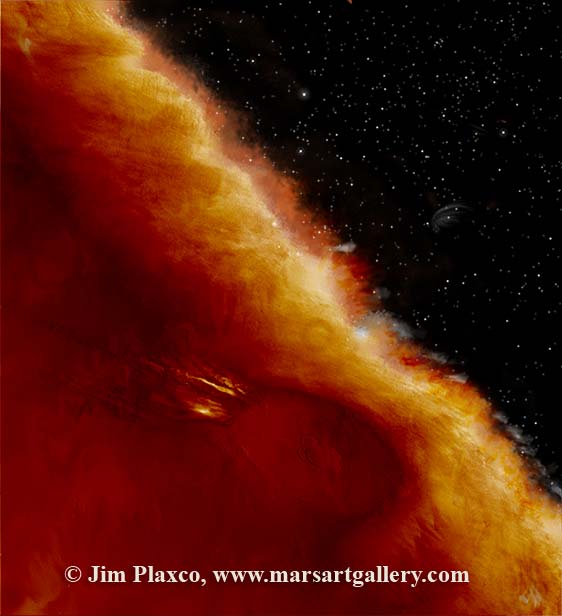Ashes Dust Stars

Image Title: Ashes Dust Stars
Source: Viking Orbiter 1
Description
I must confess that I had a difficult time coming up with a title for this image. It started out as being a simple interpretation and colorization of a Viking image of the volcano Ascraeus Mons, one of the volcanoes of the Tharsis province. The raw Viking image required a lot of cleaning, ie noise removal, in order to get it into presentable condition.
Strangely enough, it was the noise in the image that reminded me of a starfield so my next thought was to split the image between a Mars surface image and a stellar background. This led to the question of how to make the transition from the one to the other. My first thought was to make the boundary into the edge of a nebula and to call it the Ascraeus Mons Nebulae. As this progressed, the similarity between the cloudy qualities of a nebulae and of a martian dust storm gave me the final link in the chain: to go from Ascraeus Mons to a martian dust storm about to engulf the volcano into a nebulae and finally on to the star field.
This image was quite a surprise to me as the final image bears no resemblance to what I had in mind when I started out.
Source Image Background
This is a Viking Orbiter 1 morning view of the volcano Ascraeus Mons, one of the volcanoes of the Tharsis province. The image was made using the violet filter and provides an oblique low resolution view of the volcano. Centered at 11.8°N, 255.5°E, Ascraeus Mons is approximately 460 kilometers across. It is dated to the Upper Amazonian age of Mars and is judged to be the youngest of the Tharsis Montes volcanoes. It, like the other Tharsis volcanoes is a shield volcano. It straddles the Tharsis ridge and lies to the northeast of Pavonis Mons.
Image Processing
All work on this image was performed in Adobe Photoshop. The first step was to clean up the raw Viking image. The next step was to create a starfield. This was followed by producing a colorized version of the volcano. For color, I selected a palette of colors from an existing NASA color image of Mars. Finally I worked the dust storm / nebulae to achieve the feel I wanted.

